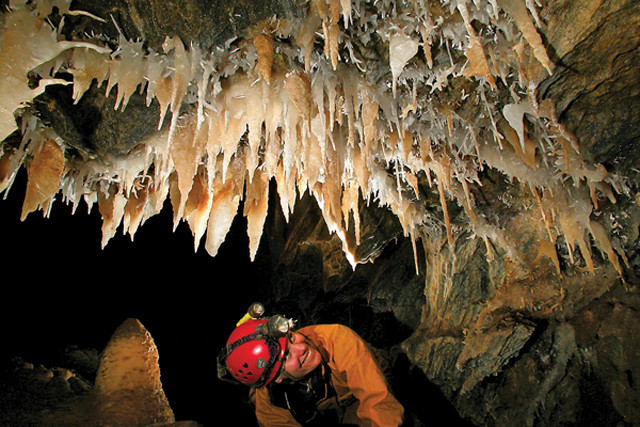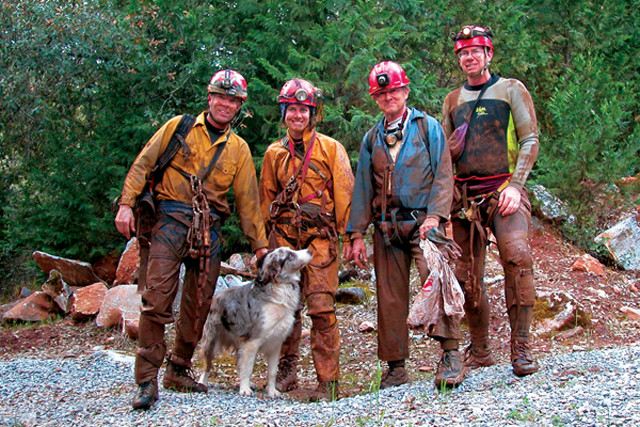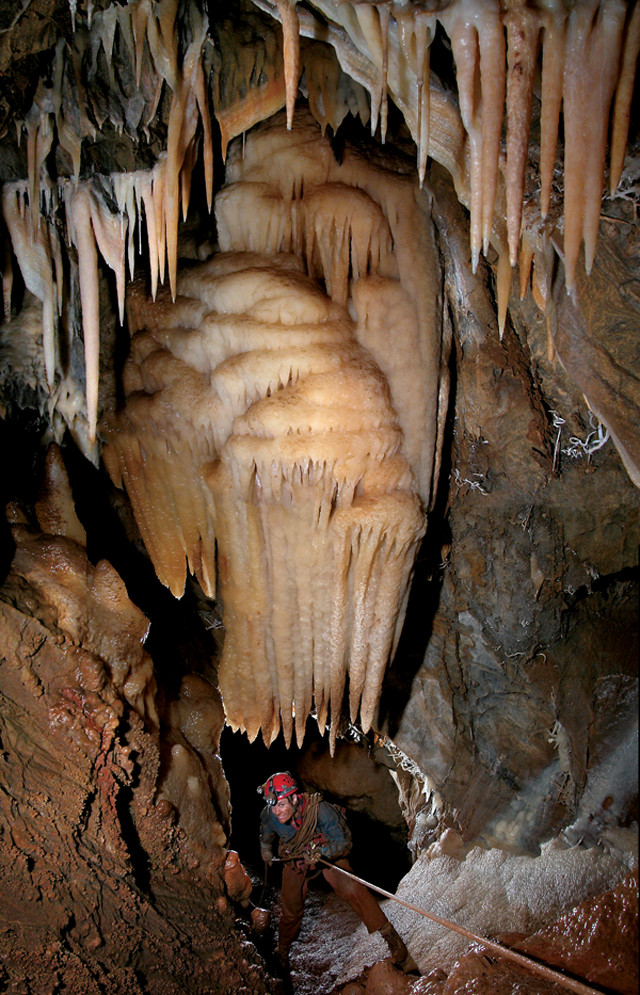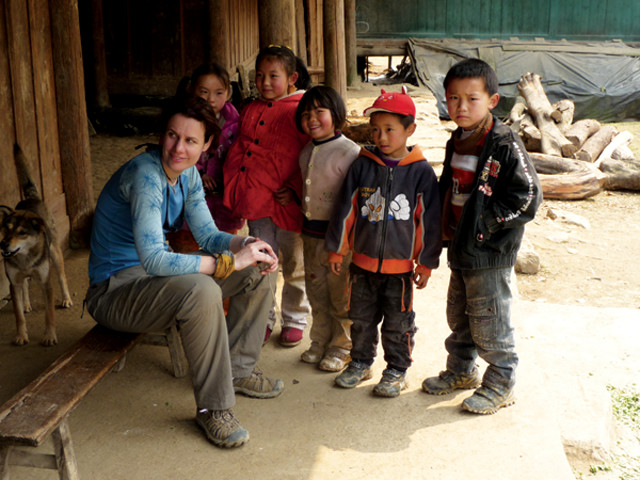
by Bethany Augliere Friday, July 21, 2017

Cave microbiologist Hazel Barton is a professor and the director of the Integrated Bioscience Program at the University of Akron in Ohio. Credit: Dave Bunnell.
In the early 1990s, when Hazel Barton was pursuing her doctorate in medical microbiology at the University of Colorado Health Sciences Center in Denver, she enjoyed exploring caves as a hobby. She never imagined that she would one day incorporate caving into her career.
Now a professor and director of the Integrated Bioscience Program at the University of Akron in Ohio, Barton examines how microbial life drives cave formation, and how it survives in isolated and nutrient-limited environments. “We still don’t completely understand how caves form,” Barton says. “Twenty-five percent of Earth’s surface is covered in rocks that sustain the formation of caves, and microbes play a big role in that.”
She’s spent hours squeezing through tight passages and rappelling down pits to explore caves on five continents, often in places no human has ever been before. In 2010, 2011 and 2013, Popular Science recognized Barton’s cave science lab as one of the “Top Ten Most Awesome Research Labs.” She even has a portion of South Dakota’s Wind Cave tattooed on her arm, which ended up being a route to one of her sample sites nearly 20 years later.
Growing up in Bristol, England, Barton wasn’t exposed much to the outdoors or to science. Her grandfather encouraged her curiosity, however, and they would occasionally spend time in the woods looking for legless lizards and other critters. “But really, there was no expectation for me,” Barton says. “Maybe that was good, because it meant I could be anything I wanted to be.”
Barton recently sat down with EARTH to discuss how she combined caving with microbiology, her quest to understand how caves form, and what it’s like to work underground for days at a time.
BA: How did you begin__ caving?__
HB: I took an Outward Bound course at age 14 and caving was a part of that. All the kids in our school had to take the course, whether they wanted to or not. It was one of the first times I had been away from home. In the cave, I remember, some kids were absolutely terrified. One boy’s light went out on his helmet and he was freaking out, so I gave him mine and just stayed close to him. It didn’t faze me — I loved the cave.
Then, at 16, I took a sports elective with a teacher who was president of the local caving club. Every Wednesday afternoon we’d hop in a minivan with our teacher and go caving in the nearby Mendip Hills, which are limestone and full of caves. I think if the [school] administrators had known what we were doing they would’ve been horrified, because we were free-climbing down pits using ropes. After that year, we weren’t required to do a sports elective, but the group of us just continued to cave ourselves. That was the beginning of me caving on a regular basis.

Barton and colleagues on a surveying trip to Black Chasm Cave in California. Credit: Dave Bunnell.
BA: How did you combine caving with your microbiology__ career?__
HB: My doctorate was in medical microbiology, and I worked on the bacteria that cause infections in cystic fibrosis patients. On the weekends and on holiday I would go caving in South Dakota (Wind Cave) and New Mexico (Carlsbad Caverns). My advisor at the time often told me that caving was a distraction from my research and I wouldn’t be able to finish my doctorate. He was very much opposed to it, even though I was still working 14 hours a day, six days a week.
Then I did a post-doc with Norm Pace at the University of Colorado Boulder. Norm is one of the most famous microbiologists in the United States and he’s also an accomplished caver. I was looking at the calcareous lesions that form on the lungs of tuberculosis patients. The human immune system tries to put a case around the infection and contain it. So, I got very good at extracting DNA from small amounts of calcium-rich material. Chemically speaking, these lesions are not that different from the kinds of rocks that make up caves.
One day, Norm and I were talking in the lab about careers and my increasing lack of enthusiasm for medical microbiology, which required me to be in the lab all the time. We started talking about caves and he said, “Why don’t you go see what’s down there?” Until that point, there had only been one published study on the microbiology of caves using modern molecular techniques — and Norm had done it.
BA: How do you study cave microbial__ life?__
HB: The first studies on microbes in caves were done 100 years ago, and the researchers only used cultures. We know that this only allows us to see about 0.1 percent of all the microbes that are actually active in the environment. Most of the microbes that grow in caves are so specialized that if you put them on a regular agar Petri plate, they die. You have to create these very exotic media. Most people would go in with regular Petri plates, which contain a lot of salt, and nothing would grow. So, the thought was that caves were naturally barren and sterile, except for some soil contamination.
With Norm’s help, I was the first to study a cave where there was no obvious life. Most other researchers had focused on sites where there was lots of microbial growth, where it was easy to extract DNA, but my research on the caseous lesions meant that I had the skill set to collect DNA from areas without obvious signs of life. We use DNA like a molecular barcode, which allows us to identify microbes whether they grow [in cultures] or not. We found hundreds of species representing 24 different bacterial phyla. So, cave ecosystems are actually remarkably diverse, and I have spent the rest of my academic career trying to understand why.
BA: Recently, you found evidence of antibiotic resistance 400 meters underground in Lechuguilla Cave in New Mexico. How are microbes at those depths developing__ resistance?__
HB: It takes 10,000 years for water to get from the surface to these locations in Lechuguilla Cave, and so we know for a fact there are no antibiotics made by humans down there. We tested 90 bacterial cultures and found them resistant to every natural antibiotic used by doctors. That’s not too surprising because most of our antibiotics come from other microorganisms, and these organisms live in a harsh environment with limited resources. Because these resources are so limited, they fight other microorganisms for access. One way they do that is through the production of chemical weapons — what we call antibiotics. So, if you want to defend yourself in this environment, you need to be resistant to those weapons.
One of these bacterial cultures, called Paenibacillus, was resistant to everything we tried. A colleague sequenced the genome and found that it was resistant to 26 different classes of antibiotics, including five that were brand new. The really cool thing about that is, if we know what resistance might look like before it ever emerges in the clinic, we can come up with ways of treating or preventing that resistance.

Barton and a colleague collect samples of cave deposits to examine for microbial life. Credit: Hazel Barton.

Barton rappels beneath speleothems in Black Chasm Cave. Credit: Dave Bunnell.
BA: What has this work taught us about antibiotic resistance__ broadly?__
HB: These bugs have been isolated for 4 million years. They’ve never been exposed to any of the antibiotics we use as a treatment, yet they carry all the resistance mechanisms. That means that resistance is at least 4 million years old. And it means we need to change our whole concept of antibiotic treatment, because it doesn’t matter what new drug you identify — there will be resistance to it. Resistance is hardwired — it’s ancient and bugs have been doing this for a lot longer than we thought.
BA: What are the big questions remaining for cave microbiology?
HB: Understanding the role of microbes in cave formation is the big question. They can accelerate all processes in the cave, from the dissolution of the rock to the formation of the speleothems you find in there. You can have caves form entirely by abiotic processes, but they would be fairly small and pretty uninteresting because they’d be unlikely to allow human entry. Microbes are the only reason that some really big caves even exist.
BA: What is your involvement in studying White Nose Syndrome in__ bats?__
HB: White Nose Syndrome (WNS) is caused by a pathogen — a fungus — that’s affecting bats that hibernate in caves. I first heard about it in spring 2007 [when it appeared in Upstate New York] and figured it was a local issue. Then in 2008, it made a 500-kilometer jump to West Virginia and I could see the future of this thing. I called up David Blehert at the U.S. Geological Survey, who was the scientist who had done the first work on WNS and later identified that it was caused by a fungus. I asked what I could do to help. They actually needed someone to work on decontamination because they didn’t know how to kill it.
We needed to figure out how you kill this on your [caving] gear so you can safely go from cave to cave. We did all the studies on what chemicals kill the fungus. We found that heat and chemical disinfection using bleach or quaternary ammonium compouwork really well. After we figured out how to kill it, we then secured funding to look at how it actually lives within caves, and how it’s related to other species that are naturally found in caves. We’ve looked at its genetic structure, how it grows in the environment, how it competes with other organisms. And we’ve done a lot of work to try to understand the ecology of the organism in a broader context.
Certain bats are resistant to WNS, so now we are trying to understand why. It looks like commensal organisms — microorganisms that naturally live on bats — are involved, which may be preventing the fungus from killing the bats. We’re also looking at how the fungus could be moved around by people visiting caves.
I’ve been in WNS caves where carcasses of bats are ankle deep. So, because of WNS, I actually have three sets of caving gear. I have one set of gear for known WNS-carrying caves, a second set for caves inside or near the WNS epidemic zone [where the presence or absence of fungus hasn’t been confirmed], and a third set for caves far from the WNS epidemic. So there’s no risk of transporting the fungus because I use a completely different set of gear. I even have a separate lab here for WNS research, and that’s where all our WNS caving kits stay.
BA: What is it like to spend so much time underground? Are you ever__ afraid?__
HB: I’ve done more than 20 expeditions to Lechuguilla Cave. The expedition trips are usually a week long, and we camp underground. About four days into the trip, you start to feel a bit cranky, frustrated by people, and everything is annoying. Then someone will say, “Oh, you’re just missing the sun.” Once you realize that, then you’re over it. If I do see someone panic, like a new graduate student, it’s usually right at the entrance.
I like the challenge of caving and persevering under tough conditions. I have to wear a big pack that weighs 18 kilograms, climb ropes, squeeze through passages; it’s hot and exhausting. But at the end, there is a powerful feeling of accomplishment. I’ve been on expeditions where we’ve found new caves, and been to places where humans have never set foot before — it’s like being on the moon. That feeling is addicting, and I just want to chase it. So, you push and wiggle to do everything you can to find more caves.
What does make me nervous or scared is water. I dislike the possibility of death by drowning. I’ve had a couple of near drowning experiences. One was in China and we had to get out of the cave, moving a mile upstream with a really epic river coming down. There were a couple of places where we thought, if we can’t get around this next corner, we are stuck. But we always found a way around. It makes me feel anxious just talking about it!

Barton visits with children during a recent caving trip in China. Credit: Hazel Barton.
BA: What do cave exploration and microbiology have in__ common?__
HB: Cave exploration is as much about solving problems as science. Caving and science attract the same kind of personality. I think the reason I’ve been a successful cave microbiologist is because I’ve spent so much time in caves when I’m not doing science. I get the map out to try to understand the hydrology and the geology. I’d say about 70 percent of our sample sites are places where I’ve noticed something looks weird or odd. Then we sample it and find something interesting. It’s important as a scientist to observe and understand your environment.
© 2008-2021. All rights reserved. Any copying, redistribution or retransmission of any of the contents of this service without the expressed written permission of the American Geosciences Institute is expressly prohibited. Click here for all copyright requests.